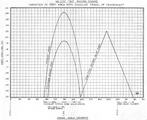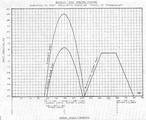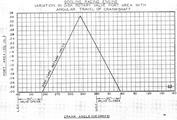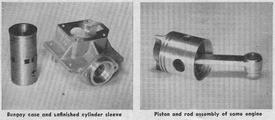Hot Engine Design |
|
IN THE design of racing engines, where the chief objective is maximum output, particular attention must be given to proper portings, port timing, compression ratio, and reduction of reciprocating weight. For high operating speeds, the cylinder intake and exhaust ports should be large, but the amount of port area obtainable is limited by the circumference of the cylinder, which places a limit on port width, and by the port timing, which limits port height, for even in a racing engine the ports cannot be opened too early.
Consideration must be given to the disposition of available space between intake and exhaust ports. Usually the area of the exhaust port is made greater than that of the intake port. Intake port area should be large, however. Manufacturers of racing engines have not always taken full advantage of the available space for porting. Even in the Hornet, which has an outstanding performance record, it is only in the converted model that maximum intake port area is provided. An increase in intake port area of approximately 75%, together with certain other changes including a lighter piston, has resulted in the brake horsepower being increased about 50%, according to figures given out by the manufacturer.
By increasing intake port area 50%, the speed of the Bungay 600 has been increased 1,000 rpm, that is, to over 21,000 rpm. What is probably the extreme limit of port area is found in the Dooling, where the five intake and six exhaust openings completely ring the cylinder with very narrow bridges between each opening.
Among the curves presented here, is one which shows not only the port timing of a typical crankshaft rotary valve racing engine-the Bungay 600-but also the variation in port area with angular travel of the crankshaft. It will be seen that the exhaust port opens 70� befor4i bottom dead center. The rising curve is steep and convex, which shows that the port opens rapidly, but the area becomes greater at a decreasing rate because the piston is decelerating. The intake port opens 63� before bottom dead center, that is, 7� after the exhaust port opens. When the piston reaches the bottom of its stroke and the ports are wide open (peaks of the curves), it will be seen that the intake port area is .166 sq. in. and the exhaust port area .281 sq. in. As the piston moves up, the ports close slowly at first and then more rapidly as the speed of the piston increases. Both ports close at the same number of degrees after bottom dead center that they opened before bottom dead center.
The graph shows that the shaft type rotary valve starts to open at 69� after bottom dead center or just about as the exhaust port closes. It opens at a uniform velocity for 60� when it is fully open. It remains open for 50 � and then starts to close at uniform velocity. It is fully closed at 59� after top dead cen,ter, the total period of opening being 170�.
While it is comparatively easy to plot the rotary valve graph, in order to plot the cylinder intake and exhaust port curves it is necessary to calculate or determine graphically the distances the piston moves for each 10� of crank rotation and then calculate the partial port areas corresponding to each of these distances. The length of the connecting rod must be known since this affects the piston motion.
Because of the angularity of the connecting rod-which increases as the length of the rod is decreased-on the down stroke the piston accelerates to maximum speed in less than 90� of crankshaft rotation, and therefore has correspondingly more than 90� of shaft rotation to decelerate to zero speed, reached at end of the stroke (180� of shaft rotation). Since at any given engine speed degrees of crankshaft rotation correspond to units of time, this shows that the piston has less time to accelerate to maximum speed than it has to decelerate to zero speed. Going up, the piston has more time to accelerate than to decelerate. These irregularities would be eliminated if the rod could be made infinitely long.
The inertial forces due to the varying speed of the reciprocating parts are the chief cause of engine vibration and high bearing loads. While the energy stored in the reciprocating parts during acceleration is returned to the crankshaft during deceleration, if the parts are heavy, the inertia forces and therefore the bearing loads will be higher, and engine power will be reduced because of frictional losses. Since the inertia forces increase as the square of the engine speed, the importance of keeping the reciprocating weight of high-speed engines low is obvious. Because the extreme upper end of the connecting rod is entirely reciprocating weight and the extreme lower and entirely rotating weight, it is usual to assume that one-half of the weight of the rod is reciprocating weight.
The primary unbalanced inertia forces are those due to variation in piston speed (neglecting the irregularity caused by rod angularity) while the secondary unbalanced inertia forces are those due to rod angularity alone. In a single-cylinder engine both cause vibration, although the former can be reduced by a crankshaft counterbalance weight. Increasing the length of the connecting rod decreases rod angularity but increases reciprocating weight, so a compromise must be made. In model racing engines the ratio of connecting rod length to stroke usually is around 1.66 to 1. In the Bungay the ratio is 1.68 to 1. The Hornet has about the same ratio. The McCoy 60 has a somewhat longer rod, the ratio of rod-length to stroke being 1.84 to 1.
Most manufacturers of racing engines, including McCoy, Hornet, Dooling and Orr, prefer the backplate or disk rotary valve to the hollow crankshaft type. With this design the end of the crankpin projects into a hole in the disk so the disk revolves with the crankshaft. The rear of the crankcase forms the seat of the valve. A long slot in the disk registers for the proper interval with the port in the backplate to which the carburetor is connected. Gas pressure combined with the capillary attraction of the oil film hold the disk to its seat. The rotary disk design permits a larger port area to be used because the port is not limited by the diameter of the crankshaft. The path from carburetor to crankcase is direct, so the gas mixture is not required to turn any sharp bends.
Also presented is a graph showing the variation in port area with shaft rotation in the disk rotary valve used on the Dooling. The figures are based on measurements rather than on data supplied by the manufacturer and therefore are approximate. It will be seen that the disk valve opens faster than the shaft type valve. The maximum opening is more than twice as great, although this may not mean too much because the passage to the carburetor has a cross-sectional area of less than one-half the area of the disk valve opening. Curves showing the variation in rotary valve and cylinder port area with shaft rotation in the case of the McCoy 60 are shown at the start of this article.
An objection to the disk rotary valve is that it is difficult to supply the bearing supporting the disk with adequate lubrication and sometimes this bearing overheats and fails. Some experienced modelers install a special ball bearing at this point. A ball bearing is standard equipment on the Orr 65 engine. It would seem that the use of an Oilite bearing at this point would provide a simpler solution to the difficulty. Oilite bearings are pressed from powdered bronze and graphite and oil-impregnated. Disk valves must be carefully fitted with the proper clearance between the disk and its seat (from .001 to .002 in.) to reduce drag and wear.
The shaft type of rotary valve is easy to lubricate and involves less frictional loss, but with this type it is difficult to provide a free gas flow to the crankcase, the hollow shaft in particular tending to be a bottleneck. Nevertheless, with careful design the shaft type' rotary valve gives good results. I have had direct experience with the operation of two racing engines using shaft type rotary valves-the Ball and Bungay-and have found both to be fast and efficient.
In most racing engines the bypass or transfer passage is run from the cylinder intake port directly to the crankcase, with the addition in some cases (as in Hornet, McCoy and Bungay) of small auxiliary ports in the lower part of the cylinder wall and piston skirt. In the Dooling, however, all the gas mixture passes through large ports in the piston skirt and cylinder wall and then to the cylinder intake port by way of a very large, curved bypass.
The stroke of model racing engines is usually made a little less than the bore. The Dooling is a very short-stroke engine, the stroke-bore ratio being .74 to 1. The short-stroke design tends to result in a compact engine of low weight.
It may be pointed out that the stroke/bore ratio used does not affect the amount of gas expansion during the power stroke. It is obvious that with two engines of the same piston displacement but different stroke-bore ratios, the initial- to - final volume of the cylinder will be the same, assuming the same compression ratio is used. Or, if we consider the bore to remain fixed and the stroke increased, which will increase the displacement of the engine, then a greater charge will be taken in during the intake period and so expansion will be no greater, assuming the compression ratio is maintained constant. In other words, gas expansion is not a function of the stroke-bore ratio. And regardless of the stroke-bore ratio used, any desired compression ratio may be chosen.
When two engines with the same displacement and general design, but different stroke-bore ratios are operating at the same number of rpm, they will both be handling the same amount of gas per' minute and should develop the same power, but the piston speed of the short stroke engine will be lower. A low piston speed is favorable to reduced piston wear!
The thermal efficiency of an engine is the percent of heat units of the fuel that is transformed into work. The thermal efficiency increases as the compression ratio is increased, but for ratios above 11 to 1, the increase in efficiency is small. I know of two manufacturers who experienced an actual falling-off in engine power, when the compression ratio was raised above 11 to 1. The cause may have been detonation, although methanol does I not usually have much tendency to detonate. The cause of detonation is not fully understood despite the extensive research work on this subject. One theory is that after the gas in the vicinity of the spark plug is ignited, the rapidly moving flame front compresses and heats the remaining portion of the charge so that it reaches the self-ignition point and explodes violently.
The shape of the combustion chamber has a marked effect on detonation. In two-cycle engines the shape of the combustion chamber is influenced by the shape of the piston head, which must be designed to form a baffle to prevent the incoming charge from passing out of the exhaust port. Manufacturers of racing engines are giving considerable attention to improved piston head design. In the McCoy 60 the contour of the piston head has been changed for better performance with hot fuels. The piston is now made of a special aluminum alloy with higher heat resisting properties and is webbed inside.
Presented in the accompany tables are the cylinder port timing for two Class D racing engines and a Class B engine; the rotary valve timing for four Class D engines and a Class B engine; and the weights of the reciprocating parts of four Class D engines.
Exhaust | Inlet | |||
|---|---|---|---|---|
| Engine | Open BBCD | Close ABDC | Open BBDC | Close ABDC |
| Bungay 60 | 70.0° | 63.0° | 70.0° | 63.0° |
| McCoy 60 | 68.5° | 55.5° | 68.5° | 55.5° |
| Forster 60 | 65.0° | 55.0° | 65.0° | 55.0° |
Cylinder Port Timing | ||||
| Engine | Valve Type | Opens ABDC | Closes ATDC | Duration |
|---|---|---|---|---|
| Ball 60 | Shaft | 50° | 70° | 200° |
| Bungay 60 | Shaft | 69° | 59° | 170° |
| Dooling 60 | Disc | 55° | 55° | 180° |
| McCoy 60 | Disc | 56° | 56° | 180° |
| Forster 60 | Disc | 25° | 40° | 195° |
Rotary Valve Timing | ||||
| Engine | Piston+rings | Wristpin | conrod | piston+rod assy |
|---|---|---|---|---|
| Ball 60 | .418 | .098 | .114 | .631 |
| Bungay 60 | .256 | .062 | .150 | .468 |
| Hornet 60 | .302 | .117 | .187 | .606 |
| McCoy 60 | .382 | .096 | .169 | .647 |
Weight of Reciprocating Parts (oz) | ||||
Ref: Model Airplane News, November 1949, p26



